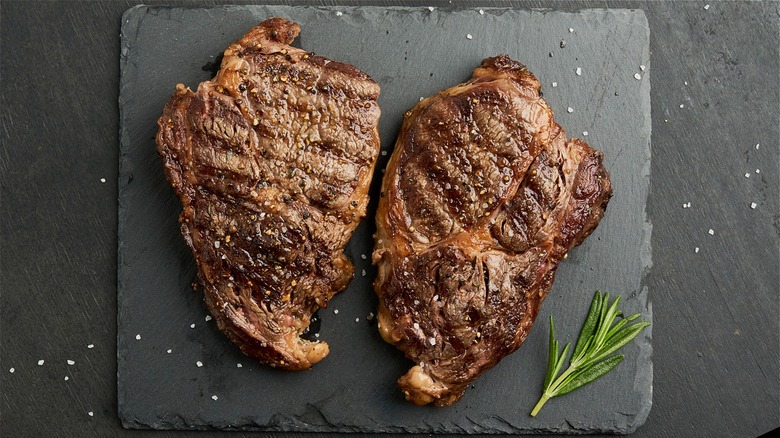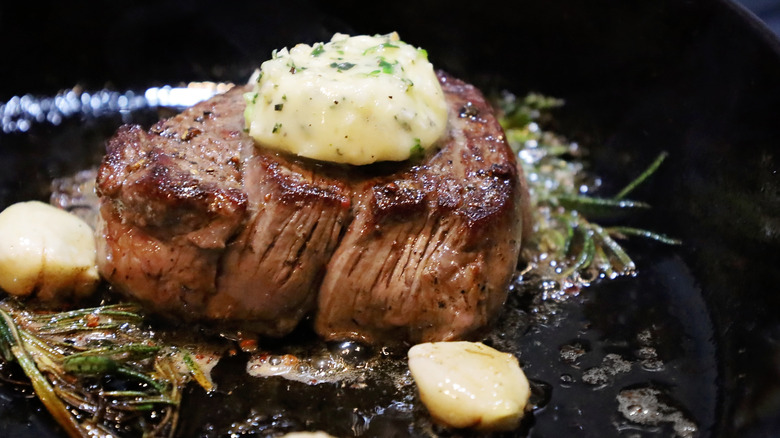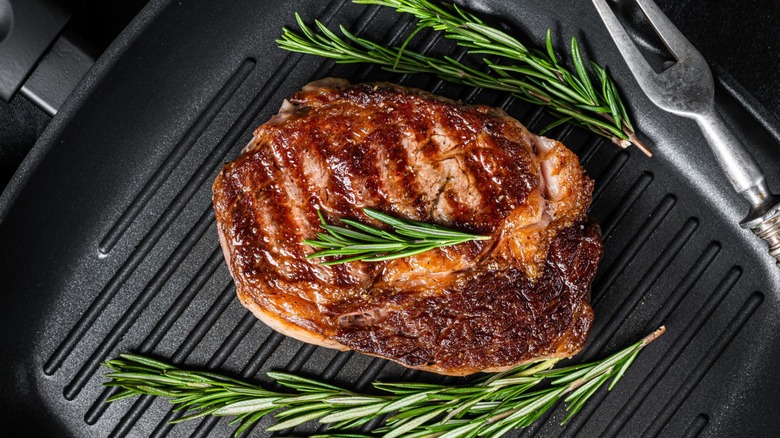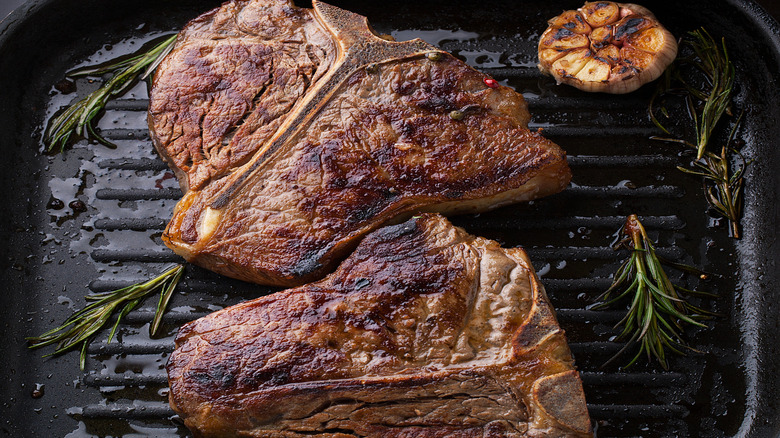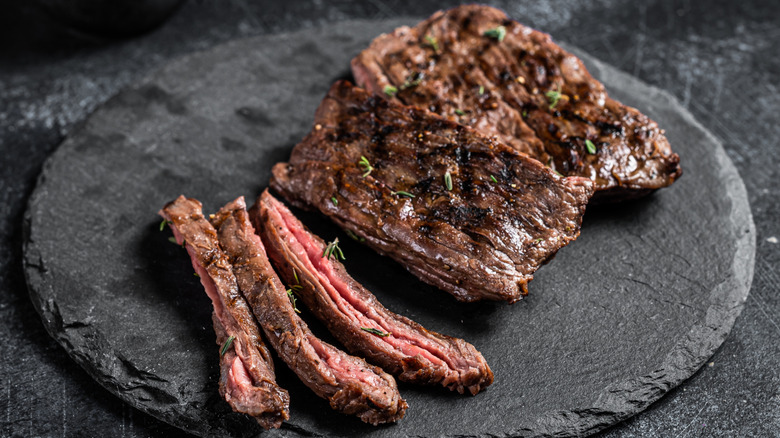From Ribeye To T-Bone: Steakhouse Chef Reveals The Perfect Pan For 4 Cuts Of Steak
Cooking steak is an art, and like any masterpiece, its success depends on the right techniques and tools. The trick is to pair each cut with a cooking surface that enhances its top qualities. Choosing the ideal pan for high-quality beef goes beyond preference or availability. It's essential to achieving the perfect sear, texture, and taste. Emmanuel Inocencio, chef de cuisine at Pechanga Resort Casino's Great Oak Steakhouse in Temecula, California, and Wine Spectator Award of Excellence recipient, shares his expert recommendations on choosing the best pan for four standout cuts: filet, ribeye, T-bone, and skirt steak.
No matter the cut you're working with, a cast iron pan reigns supreme. Known for its exceptional heat retention, durability, and naturally nonstick surface, cast iron ensures optimal fat rendering, yielding a tender, savory steak. In addition to picking cookware made from the right material, you should consider the size and shape when preparing different cuts. Chef Inocencio has advice for that as well.
Cast iron is filet mignon's best friend
Lean, delicate, and tender, filet mignon demands a pan that delivers steady, controlled heat without scorching. For a flawless sear, "Use a small, oval-shaped, thick cast-iron pan for evenly distributed heat," chef Emmanuel Inocencio advises. Since filets lack the marbling that naturally bastes fattier cuts, they should be handled with care. "Too much time on a heated surface, and the meat can burn or hit a doneness that's going to be too much for the guest — very quickly," he cautions.
The key is a two-step cooking process: a hard sear on the stovetop followed by a gentle finish in the oven. Start by heating about ½ tablespoon of grapeseed or canola oil in the cast iron. Both of these neutral oils boast high smoke points that preserve the steak's pure flavor. "Stay away from olive oil as it ... burns faster under high heat," he warns. Once the oil shimmers, sear the steak for two minutes per side, then transfer the pan to a 425-degree oven for seven minutes for a lovely medium-rare.
If you don't have a cast iron skillet, a thick-bottomed stainless steel pan is a viable alternative. "It holds more heat but takes longer to heat up, and then you have to be incredibly careful about timing the searing." The right pan (and an eye on the clock) assures that this prized cut remains succulent.
Sear ribeye in a ridged cast iron grill pan
A cast iron grill pan is the gold standard for cooking ribeye steak. "These have raised indents that ... heat up very evenly, producing a great, even crust on the steak," explains Emmanuel Inocencio. Thanks to ribeye's generous marbling, the steak bastes itself as it cooks, resulting in a rich, beefy flavor. This means there's no need for additional oil. Simply place the steak directly on the hot grill pan. "The natural fats and oils will render out, helping the steak cook and envelop its own flavors that much more," Inocencio adds.
The secret to a restaurant-worthy ribeye is patience. Allow the steak to sear undisturbed for three to four minutes per side (depending on thickness) to develop a deep, caramelized crust. For even cooking, transfer the entire grill pan to an oven preheated to about 250 degrees and let the steak bake for four to five minutes. Once out of the oven, resist the urge to slice immediately. Give the meat at least five minutes to rest. The result is an evenly cooked ribeye with pronounced grill marks and a rich, brown crust.
A juicy T-bone steak calls for a large cast iron pan
One thing you should know about T-bone steaks is that size matters — not only when it comes to the meat but also the pan. Plenty of room, high heat, and minimal time on the pan are the keys to a mouthwatering T-bone. "Cast iron is always my choice [for T-bone]," chef Emmanuel Inocencio shares. "You're going to want a large, probably round or somewhat rectangular cast iron pan [or a] grill pan." A heavyweight like Great Oak Steakhouse's signature 40-ounce T-bone, for instance, requires careful pan rotation to guarantee even cooking across its massive facet.
If you don't have a big enough cast iron skillet for a gigantic T-bone, a trusty outdoor grill is an excellent alternative. (In fact, we've ranked T-bone as the third-best cut of steak to grill, just behind porterhouse and ribeye.) However, regardless of your preferred cooking method, the approach remains the same: "Put the T-bone on for three to four minutes per side. If you're using the grill, close the lid for a large steak," he suggests. For smaller T-bones, consider breaking the cut into its two main components — the New York strip and the tenderloin — for more precise cooking. "If you have these pieces separately, cook them the same way as the T-bone, but sear for about three minutes on each side and finish it in the oven."
Grab a small cast iron pan for skirt steak
"One thing I tell my chefs: The smaller the pan, the less you have to clean," Emmanuel Inocencio remarks. When it comes to skirt steak, a compact cast iron pan isn't just convenient — it's strategic. The high heat retention and tight cooking surface help create the quick sear necessary for this long, thin, intensely flavorful cut. Skirt steak is famous for its loose muscle fibers and moderate fat content, which contribute to its umami, beefy taste. A light oiling before it hits the pan helps maximize caramelization without excess grease. "You can get away with using a small amount of oil or butter, then putting the steak down to sear [for] a few minutes on both sides," he advises.
Because skirt steak cooks rapidly, it's best enjoyed medium-rare or rare. Any longer, and it risks turning tough. While it's often marinated for extra tenderness, a simple seasoning of salt and pepper allows its inherent richness to shine. When used in dishes like fajitas or stir-fry, the residual heat continues cooking the narrow slices after they leave the pan, so pulling them a touch early prevents them from becoming overdone. No cast iron? No problem! "A stainless steel pan will also work for a skirt steak," he assures. In this case, be sure the steel is ripping hot before the steak hits the metal — because with a cut this brisk, every second counts.
